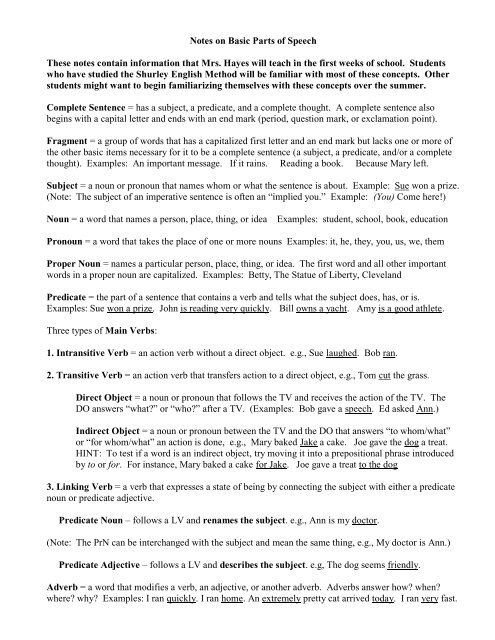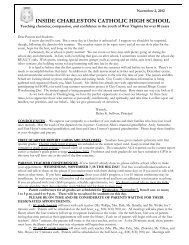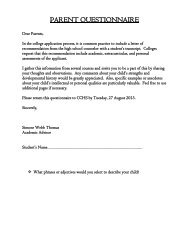Notes on Basic Parts of Speech - Charleston Catholic High School
Notes on Basic Parts of Speech - Charleston Catholic High School
Notes on Basic Parts of Speech - Charleston Catholic High School
Create successful ePaper yourself
Turn your PDF publications into a flip-book with our unique Google optimized e-Paper software.
<str<strong>on</strong>g>Notes</str<strong>on</strong>g> <strong>on</strong> <strong>Basic</strong> <strong>Parts</strong> <strong>of</strong> <strong>Speech</strong><br />
These notes c<strong>on</strong>tain informati<strong>on</strong> that Mrs. Hayes will teach in the first weeks <strong>of</strong> school. Students<br />
who have studied the Shurley English Method will be familiar with most <strong>of</strong> these c<strong>on</strong>cepts. Other<br />
students might want to begin familiarizing themselves with these c<strong>on</strong>cepts over the summer.<br />
Complete Sentence = has a subject, a predicate, and a complete thought. A complete sentence also<br />
begins with a capital letter and ends with an end mark (period, questi<strong>on</strong> mark, or exclamati<strong>on</strong> point).<br />
Fragment = a group <strong>of</strong> words that has a capitalized first letter and an end mark but lacks <strong>on</strong>e or more <strong>of</strong><br />
the other basic items necessary for it to be a complete sentence (a subject, a predicate, and/or a complete<br />
thought). Examples: An important message. If it rains. Reading a book. Because Mary left.<br />
Subject = a noun or pr<strong>on</strong>oun that names whom or what the sentence is about. Example: Sue w<strong>on</strong> a prize.<br />
(Note: The subject <strong>of</strong> an imperative sentence is <strong>of</strong>ten an “implied you.” Example: (You) Come here!)<br />
Noun = a word that names a pers<strong>on</strong>, place, thing, or idea Examples: student, school, book, educati<strong>on</strong><br />
Pr<strong>on</strong>oun = a word that takes the place <strong>of</strong> <strong>on</strong>e or more nouns Examples: it, he, they, you, us, we, them<br />
Proper Noun = names a particular pers<strong>on</strong>, place, thing, or idea. The first word and all other important<br />
words in a proper noun are capitalized. Examples: Betty, The Statue <strong>of</strong> Liberty, Cleveland<br />
Predicate = the part <strong>of</strong> a sentence that c<strong>on</strong>tains a verb and tells what the subject does, has, or is.<br />
Examples: Sue w<strong>on</strong> a prize. John is reading very quickly. Bill owns a yacht. Amy is a good athlete.<br />
Three types <strong>of</strong> Main Verbs:<br />
1. Intransitive Verb = an acti<strong>on</strong> verb without a direct object. e.g., Sue laughed. Bob ran.<br />
2. Transitive Verb = an acti<strong>on</strong> verb that transfers acti<strong>on</strong> to a direct object, e.g., Tom cut the grass.<br />
Direct Object = a noun or pr<strong>on</strong>oun that follows the TV and receives the acti<strong>on</strong> <strong>of</strong> the TV. The<br />
DO answers “what?” or “who?” after a TV. (Examples: Bob gave a speech. Ed asked Ann.)<br />
Indirect Object = a noun or pr<strong>on</strong>oun between the TV and the DO that answers “to whom/what”<br />
or “for whom/what” an acti<strong>on</strong> is d<strong>on</strong>e, e.g., Mary baked Jake a cake. Joe gave the dog a treat.<br />
HINT: To test if a word is an indirect object, try moving it into a prepositi<strong>on</strong>al phrase introduced<br />
by to or for. For instance, Mary baked a cake for Jake. Joe gave a treat to the dog<br />
3. Linking Verb = a verb that expresses a state <strong>of</strong> being by c<strong>on</strong>necting the subject with either a predicate<br />
noun or predicate adjective.<br />
Predicate Noun – follows a LV and renames the subject. e.g., Ann is my doctor.<br />
(Note: The PrN can be interchanged with the subject and mean the same thing, e.g., My doctor is Ann.)<br />
Predicate Adjective – follows a LV and describes the subject. e.g, The dog seems friendly.<br />
Adverb = a word that modifies a verb, an adjective, or another adverb. Adverbs answer how? when?<br />
where? why? Examples: I ran quickly. I ran home. An extremely pretty cat arrived today. I ran very fast.
Helping Verb = a verb placed in fr<strong>on</strong>t <strong>of</strong> the main verb. There are 23 HVs: be, being, been, is, am, are,<br />
was, were, has, have, had, do, does, did, can, could, will, would, should, may, might, must, shall<br />
Note! The above words are not always helping verbs. They are <strong>on</strong>ly helping verbs if they are<br />
followed by a main verb (transitive, intransitive, or linking)<br />
Verb Phrase = a main verb preceded by <strong>on</strong>e or more helping verbs<br />
Adjective = a word that modifies a noun or pr<strong>on</strong>oun. Answers what kind? which <strong>on</strong>e? how many?<br />
Examples: a red car, the last story, several pencils, six dogs<br />
Article Adjectives = a, an, the<br />
7 Possessive Pr<strong>on</strong>oun Adjectives = my, our, his, her, your, their, its<br />
Possessive Noun Adjectives = nouns that indicate possessi<strong>on</strong> and act as adjectives.<br />
Examples: the dog’s bowl, Tom’s car, my parents’ room<br />
Coordinating C<strong>on</strong>juncti<strong>on</strong>s = words that join two words or groups <strong>of</strong> words <strong>of</strong> equal importance<br />
7 CCs: for and nor but or yet so (FANBOYS) Note: for can also be a prepositi<strong>on</strong>, yet and<br />
so can also act as adverbs<br />
Prepositi<strong>on</strong>s = A word that introduces a noun or pr<strong>on</strong>oun called the object <strong>of</strong> the prepositi<strong>on</strong> to create a<br />
“prepositi<strong>on</strong>al phrase.” Examples: about, after, before, behind, by, down, from, in, near, <strong>of</strong>, <strong>of</strong>f, outside,<br />
over, up, with. (NOTE—Some words, such as <strong>on</strong> or inside, can simply be acting as adverbs if they are<br />
not followed by an “object <strong>of</strong> the prepositi<strong>on</strong>.” Examples: The light is turned <strong>on</strong>. Tom went inside.)<br />
Prepositi<strong>on</strong>al Phrase = a group <strong>of</strong> words acting as an adjective or adverb that begins with a prepositi<strong>on</strong><br />
and ends with an object <strong>of</strong> the prepositi<strong>on</strong>.<br />
Examples: Bob placed the book <strong>on</strong> the table. (On the table is acting as an adverb, telling you where.)<br />
A man with an orange shirt ran inside the bank. (With an orange shirt is acting as an adjective<br />
describing the man; inside the bank is acting as an adverb telling you where the man ran.)<br />
REMEMBER! An “object” (e.g., an OP, DO, or IO) is always a noun or pr<strong>on</strong>oun.<br />
Strategy: When searching for the simple subject and predicate <strong>of</strong> a sentence, place the prepositi<strong>on</strong>al<br />
phrases in parentheses because prepositi<strong>on</strong>al phrases always act as modifiers (they are extras).<br />
Abbreviati<strong>on</strong>s you’ll need for labeling the words in sentences:<br />
A = article adjective (a, an, the)<br />
CC = coordinating c<strong>on</strong>juncti<strong>on</strong> (the FANBOYS)<br />
SN = subject noun<br />
SP = subject pr<strong>on</strong>oun<br />
IV = intransitive verb<br />
TV = transitive verb<br />
DO = direct object<br />
IO = indirect object<br />
LV = linking verb<br />
PrN = predicate noun<br />
PrA = predicate adjective<br />
HV = helping verb<br />
Adj = adjective<br />
Adv = adverb<br />
PPA = possessive pr<strong>on</strong>oun adjective (e.g., my, his)<br />
PNA = possessive noun adjective (e.g., Ed’s car)<br />
P = prepositi<strong>on</strong><br />
OP = object <strong>of</strong> the prepositi<strong>on</strong>









